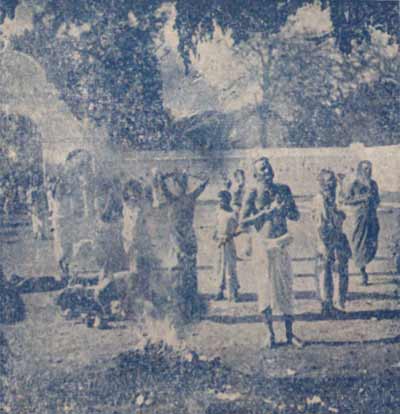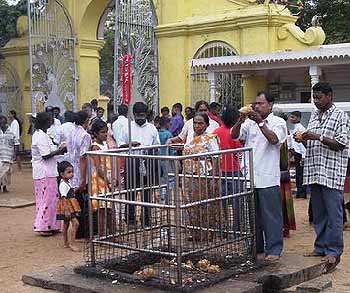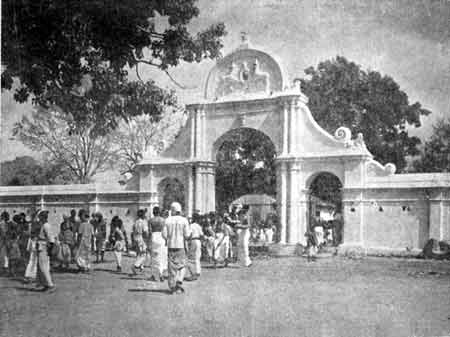|
| |||||||||||||||||
Hazards of Kataragama in the 1940s
July is festival time in Kataragama, the holy city in south Sri Lanka. It is one of the biggest religious festivals for Hindu devotees. Many Buddhists too participate in the fortnight long festival. The final night is the Maha Perahera when the main procession is held and the water-cutting ceremony is held the following morning. Although the Kataragama festival had been held for a very long time, even in the early part of the 20th Century, the trek to Kataragama was a tedious one. The area was covered by thick jungle where wild animals roamed. Malaria was prevalent in the area and at that time it was a deadly disease. An account written by Sir Ponnambalam Arunachalam, distinguished member of the Ceylon Civil Service, published in the prestigious Journal of the Royal Asiatic Society in 1924 describes the conditions in the early days: "There is on the south-east coast of Ceylon a lonely hamlet known as Kataragama in the heart of a forest haunted by bears, elephants and leopards and more deadly malaria. The Ceylon Government thinks of Kataragama especially twice a year, when arrangements have to be made for pilgrims and precautions taken against epidemics.
Hardly anyone goes there except in connection with the pilgrimage. General Brownrigg, Governor and Commander-in-Chief, visited this desolate spot in 1819 at the close of military operations in the Uva country, and seven decades later Sir Arthur Gordon (afterwards Lord Stanmore) who attended the festival in July, 1889. Sportsmen are drawn to this region by the fame of its sport, but Kataragama itself is outside the pale of their
curiosity. Few even of our educated classes know its It is possibly because of these difficult and hard conditions that over the years the pilgrims were warned to be on their best behavior in the Deviyange Rata - the Land of the Gods. They were told that they should be extremely careful in what they do, what they say and even what they eat. No fish or meat is consumed during the pilgrimage - they all remain vegetarians. They had to guard their tongue and be mindful always that they were in god's land. The strenuous journey is also echoed in the popular saying Denagena giyoth Kataragama - Nodena giyoth ataramaga - 'if you know the way you will reach Kataragama - if not, you will be stranded'. The devotees developed a feeling of fear. Kataragama according to an old Indian print
With the development of a network of roads in the country, the trip to Kataragama gradually became an easy one. Yet the holiness attached to this sacred place did not change. The discipline continued to be maintained. How did Kataragama become the land of the gods? Kataragama known to Hindus of Sri Lanka and South India as "Katirkamam" has a famous shrine dedicated to Lord Katirkaman. The presiding deity is Murugan or Skanda. God Skanda is considered Sri Lanka's guardian deity and is identified as one who can bring prosperity and protection.
As he is described in the popular Sinhala verse - Muhunu sayaki - ath dolasaki - Mayura pita vāhane - he possesses six faces and twelve hands and his vehicle is the peacock. He is depicted in this form in paintings and drawings. As they reach Kataragama, all the devotees are advised to take a dip in the Menik Ganga which flows Clad in white they will then
proceed to the devale. On reaching the devale premises, it is customary to break a coconut on a stone fixed in the soil for the purpose.
While devotees go to Kataragama to make offerings throughout the year, the annual festival is of special significance when elaborate
On normal days too offerings can be made to the deity at specific times during which the religious observances are conducted. Devotees gather in numbers with baskets of fruits in their hands which are handed over to the kapurala - the lay official in charge - and his assistants all clad in white. The offerings are taken inside and a portion is returned for the devotee to consume. Ash is applied on the forehead of each devotee who also picks up a little coconut oil from the tall brass lamps and applies on the head. The oil is taken home to be applied later since many believe this oil helps to cure illnesses. It is with a great sense of relief that devotees get back home. They return with a feeling of satisfaction that they have been to the god's country. Courtesy: The Sunday Times of Sunday July 18, 2010 | |||||||||||||||||



![Kataragama according to an old Indian print [47 kb]](../pix/old-kataragama-print980.gif)

